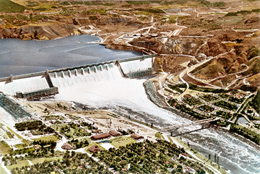On January 16, 1942, two federal agencies, the Office of Production Management (OPM) and the Bonneville Power Administration (BPA), and representatives of Northwest utilities lay the groundwork for creation of the Northwest Power Pool. The occasion is a meeting at the OPM offices in Washington, D.C., in which OPM representatives declare that the new reality following U.S. entry into World War II mandates a comprehensive, voluntary interconnection of all of the electrical systems in the Northwest -- or else the government will impose an involuntary power pool. The Northwest representatives at the meeting reply that they see no obstacles to creating a voluntary power pool and propose a framework for such a pool. In fact on the same day, across the country in Portland, Oregon, representatives of several Northwest utilities are meeting to discuss the same issue: making interconnections between their systems as soon as possible. The proposals put forth at these two meetings will result in the interconnection of 10 Northwest utilities and the BPA under the name the Northwest Power Pool on August 1, 1942.
Stretching Kilowatts
With the U.S. entry into World War II in December 1941, efficient distribution of power in the Northwest was more important than ever. Writing a decade later, BPA researcher Anthony Netboy described the wartime electricity situation:
"At home, there must be armies of workmen, plants, raw materials, machinery, and motive power to produce the ships, planes, tanks, guns, ammunition, bombs and innumerable other items needed to fight and win a war. Obviously, motive power is a prime essential. Without adequate energy, maximum production cannot be obtained ... . There was not enough electricity in the United States for the insatiable demands of civilian and military production. Kilowatts had to be stretched to the limit" (Netboy, 1).
One means of stretching kilowatts was a power pool -- "the integration of many separately-owned generating and transmission systems" that ties together "the facilities of all of its members into a kind of web" instead of having them operate as isolated systems (Netboy, 3).
Even before the U.S. entered the conflict, as wartime industry ramped up the Northwest was becoming a vital production region. With the concurrence and sponsorship of the OPM, the federal entity charged with overseeing the nation's wartime industrial push, BPA had already interconnected with several major Northwest utilities, including Washington Water Power, Pacific Power and Light, Portland General Electric, and several major municipal systems, including Seattle and Tacoma. In addition, several privately owned utilities under the Electric Bond and Share Company (EBASCO) holding company were connected to each other.
But the power pool was not yet comprehensive. At the January 16, 1942, organizational meeting with the power section of the OPM in Washington, D.C., the OPM representatives laid down the new wartime reality, as reported at a later meeting of the Northwest utilities: "All power systems must be coordinated and operated at maximum overall efficiency for the duration of the war" (Minutes, Northwest Systems ...). They also indicated that they preferred that a complete power pool be established "on a joint voluntary basis," because otherwise it would be imposed on an "involuntary basis by appointing a dictator from Washington and issuing orders" (Minutes, Northwest Systems ...).
This was a threat with some teeth. Northwest utilities had long feared that the government would institute a federal "Columbia Valley Authority" similar to the federal Tennessee Valley Authority -- a concept "bitterly opposed" by the existing utilities (Merrill Schultz interview). Faced with this choice, all parties "agreed that no inherent obstacles exist to full [voluntary] network operations of all interconnected Northwest systems" (Minutes, Northwest Systems ...). Sol Schultz, chief engineer of BPA, took the position that "it could be done cooperatively with the existing entities, and the coordinating group for EBASCO could remain as the coordinating group for the new Northwest Power Pool, and the employees could even remain as EBASCO employees, but that they would report to and be responsible to an operating committee made up of all the operating utilities" (Merrill Schultz interview). This is almost exactly how the Northwest Power Pool would later be organized. The chief engineer added that "the work to be done was largely a matter for engineers to handle and that a minimum of newspaper publicity might be desirable" (Minutes, Washington Conference with OPM).
Interconnected
On that very same day, January 16, 1942, representatives of BPA and four major utilities gathered in Portland, Oregon, to begin hashing out a larger interchange pool. Each company was asked to submit a diagram of suggested ties, after which "additional meetings will be held to attain agreement on exact construction requirements" (Memorandum). By March 1942, a coordinated plan was taking shape.
In April 1942 the War Production Board (the new name for the Office of Production Management) further encouraged BPA to arrange interconnections with the rest of the other major regional utilities. This soon went beyond mere encouragement. On May 1, 1942, the War Production Board issued Limitation Order L-94, "which made mandatory such interconnection programs" throughout the country ("Annual Report ...").
Shortly afterward, BPA had completed its interconnections with all 10 major utilities in the Northwest: Portland General Electric, Washington Water Power, Pacific Power & Light, Northwestern Electric Co. (later merged with Pacific Power & Light), Tacoma City Light, Seattle City Light, Puget Sound Power and Light, Montana Power, Idaho Power, and Utah Power. All 11 of these entities met in Spokane under the name "Northwest Power Coordination" on May 21 and 22, 1942, to hash out the details of this new partnership. On August 1, 1942, "actual operations of the Northwest power pool began," marking the formal birth of the Northwest Power Pool ("Annual Report ..."). As of 2016, the Northwest Power Pool was still pursuing its original goals: maximizing the efficiency and reliability of the Northwest's power system.

